Madagascar: A Biodiversity Hotspot
From deep oceans to scorching deserts, coral reefs to rainforests, our planet hosts an incredible range of ecosystems which support a wondrous diversity of organisms. Biodiversity is the variety of life on earth, from alpaca to zooplankton and everything in between, and as our world faces climate crisis and mass extinction, more people are paying attention to what biodiversity is and why it’s so important.
So why is biodiversity so important? The more biodiversity an ecosystem has, the more stable and productive that ecosystem is. Humans rely on biodiversity to provide us with things like food, medicine, textiles and other highly desired products. Biodiversity also mitigates pollution, disease, and climate change by supporting specialized bacteria, increasing genetic diversity, and creating carbon sinks. Since biodiversity goes hand in hand with specialization, many species in diverse ecosystems are also endemic, meaning they are found nowhere else in the world.
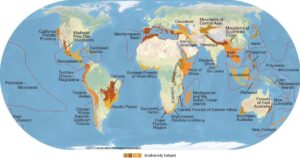
Conservation International (conservation.org) defines 35 biodiversity hotspots – extraordinary places that harbor vast numbers of plant and animals species found nowhere else. All are heavily threatened by habitat loss and degradation, making their conservation crucial to protecting nature for the benefit of all life on Earth.
Areas with high levels of biodiversity and endemism are classified as biodiversity hotspots. Biodiversity hotspots make up about 2.4% of the Earth’s land area, but contain 50% of its plant species and 42% of its land animals. Scientists recognize about 36 biodiversity hotspots on Earth which meet the criteria for biodiversity and endemism. One of these recognized hotspots is the island of Madagascar.
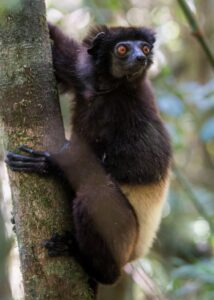
The Milne-Edwards sifaka, like most other lemur species, is not held in human care. It is found only in the primary and secondary rainforests of southeastern Madagascar.
Because Madagascar has been an island for tens of millions of years, many of the plants and animals that live there are found nowhere else, making it an extremely important biodiversity hotspot. Scientists estimate that about 90% of the plants on Madagascar are endemic, while about 85% of animals are endemic. Since these organisms have been isolated on an island for so long, millions of years of adaptive radiation has resulted in very unique and amazing species.
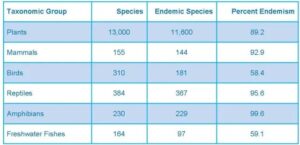
The above table refers to plant and animal species currently found on the island of Madagascar.
Some of the most loved endemic species of Madagascar are the lemurs. The only non-human primates found on the island, lemurs have likely inhabited Madagascar for around 65 million years. Today, there are around one hundred different lemur species. The diversification of lemurs has resulted in some incredible adaptations, which are helping researchers understand more about primate evolution and even about the human genome. Unfortunately, most lemur species in Madagascar are currently endangered due to habitat loss, and that same habitat loss threatens the rest of Madagascar’s endemic species.
About 80% of the world’s chameleon species are found in Madagascar, including the tiny Brookesia micra, and the 2-foot long Malagasy giant chameleon. Madagascar also hosts a wide array of snakes, lizards, geckos, and other fascinating reptiles.

Panther chameleons are sexually dimorphic: males have brilliant and striking colorful patterns on their skin and can grow up to eight inches in length.
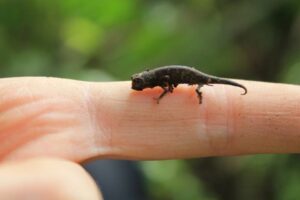
At a whopping one inch long in adulthood, the Brookesia micra is the smallest known chameleon.
Unique groups of amphibian species like the tomato frogs and the Mantella, commonly known as the Malagasy poison frogs, exclusively live in Madagascar. New species of frogs continue to be discovered all the time in Madagascar, and the number of recognized frog species almost doubled in 2009. Amphibian diversity is a helpful indicator for the effects of climate change, since this group is so dependent on precipitation and weather patterns.
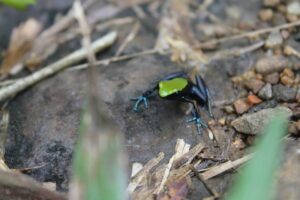
Despite the resemblance and similarities to the poison frogs of South America, members of the Mantella genus evolved separately in a Madagascar, in a phenomenon known as “convergent evolution.”
Madagascar is home to 100,000 species of insects, like the giraffe weevil and the net-throwing spider. While not all of Madagascar’s insect species are as beloved as, say, the lemurs, they can teach us incredible things about adaptation and evolution. The net-throwing spider spins a net of sticky silk which it uses to snatch up its prey, rather than waiting for insects to happen into a web. The giraffe weevil uses its long neck the same way that male giraffes do—to duel for the favor of a female.
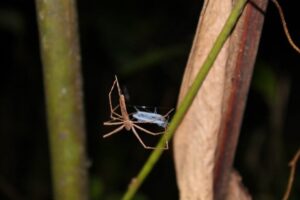
Deinopsis madagascariensis, or the Malagasy net-throwing spider, lies in wait for unsuspecting prey.

The male giraffe weevil can grow to one inch in length, and possesses a neck 2-3 times the length of the average female’s neck.
Bird-watchers from all corners of the world travel to Madagascar to see the Helmet Vanga, or other beautiful birds like the crested drongo, the Malagasy kingfisher, the paradise flycatcher, or the Vasa parrot.
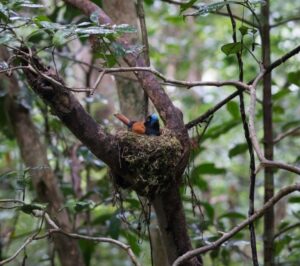
The helmet vanga is exclusively found in the rainforests of northeastern Madagascar.
But it’s not just the wildlife in Madagascar that’s so special. Many plants in Madagascar have medicinal properties. The Madagascar periwinkle may be the most well-known for its potential to help fight cancer.
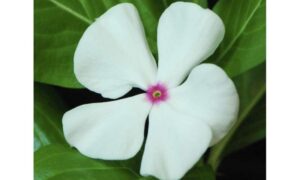
While many know the Madagascar periwinkle flower as a cultivated ornament in gardens, it has far more important scientific value in deriving cancer treatments.
Additionally, Madagascar is home to many of our favorite food plants, like vanilla, coffee, cocoa, and banana. In fact, the Madagascar banana could save commercially grown Cavendish bananas from being wiped out! Cavendish bananas are easily affected by a fungal disease that the Madagascar banana is invulnerable to. Conservationists are hoping to use the Madagascar banana to diversify the Cavendish genome and protect it from disease. Without the biodiversity of Madagascar, we would possibly be looking at a future with no banana splits!
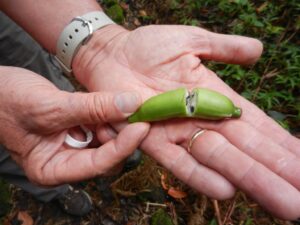
The Madagascar banana plant is critically endangered.
As extinctions climb and climate change intensifies, it is of the utmost importance that we focus our conservation efforts on biodiversity hotspots like Madagascar. Protecting these incredible places, as well as all ecosystems on Earth, helps ensure a healthy future for all life on our planet.
If you’d like to learn more about Madagascar biodiversity, we recommend checking out our sources for this article:
Marchese, Christian (2015). Biodiversity hotspots: A shortcut for a more complicated concept. Global Ecology and Conservation Volume 3, 297-309.
Hobohm, C. Characterization and ranking of biodiversity hotspots: centres of species richness and endemism. Biodiversity and Conservation 12, 279–287 (2003). https://doi.org/10.1023/A:1021934910722
Goodman, S., & Benstead, J. (2005). Updated estimates of biotic diversity and endemism for Madagascar. Oryx, 39(1), 73-77. doi:10.1017/S0030605305000128
Allen, Richard, and Dr. James Clarkson and Dr. Hélène Ralimanana (July 2018). The Critically Endangered Madagascar Banana. Kew Gardens https://www.kew.org/read-and-watch/madagascan-banana
Centre, John Innes (2018). Milestone research on Madagascar periwinkle uncovers pathway to cancer-fighting drugs. Phys Org https://phys.org/news/2018-05-milestone-madagascar-periwinkle-uncovers-pathway.html

